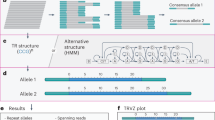Abstract
Satellite DNA comprises long arrays of tandem DNA repeats with moderate to long length, that account for the majority of heterochromatic sequences of the human genome, organizing centromeric, paracentromeric, and acrocentric regions of eukaryotic chromosomes, as well as the human Y chromosome. Tandemly repeated DNA is also found disperse in the human genome with shorter repeat motifs constituting mini- and microsatellite DNA, which are inherited in a Mendelian pattern. Their frequent length polymorphisms make them the most commonly employed DNA markers in forensic identification of individuals. In addition, microsatellite instability is a marker for detection of DNA repair deficiency in cancer. Expansions of the transcribed microsatellite repeat number in specific loci associate with rare chromosomal fragile sites and distinct neurological diseases, some of which show clinical anticipation according to further intergeneration repeat expansions. Clarification of molecular models of the genetic pathophysiology of these diseases has considerably advanced owing to the characterization of translation patterns of triplet repeat-containing mRNA and intracellular accumulation of these transcripts or unfolded proteins. The most recent technologies of massively parallel DNA sequencing generating longer reads more amenable to accurate mapping of repeats to specific chromosomal loci have been improving our understanding of the organization of tandemly repetitive DNA in the human genome and revealing novel potentially polymorphic sequences. This approach will likely add to the research in population genetics and association studies in medical genetics.
Access this chapter
Tax calculation will be finalised at checkout
Purchases are for personal use only
Similar content being viewed by others
References
Miga KH, Koren S, Rhie A, et al. Telomere-to-telomere assembly of a complete human X chromosome. Nature. 2020;585:79–88.
Allen EG, Sullivan AK, Marcus M, et al. Examination of reproductive aging milestones among women who carry the FMR1 premutation. Hum Reprod. 2007;22(8):2142–52.
Berry-Kravis E, Raspa M, Loggin-Hester L, et al. Seizures in fragile X syndrome: characteristics and comorbid diagnoses. Am J Intellect Dev Disabil. 2010;115(6):461–72.
Bragg DC, Sharma N, Ozelius LJ. X-linked dystonia-parkinsonism: recente advances. Curr Op Neurol. 2019;32(4):604–9.
Britten RJ, Kohne DE. Repeated sequences in DNA. Science. 1968;161(3841):529–40.
Buijsen RAM, Visser JA, Kramer P, Severijnen EAWFM, et al. Presence of inclusions positive for polyglycine containing protein, FMRpolyG, indicates that repeat-associated non-AUG translation plays a role in fragile X-associated primary ovarian insufficiency. Hum Reprod. 2016;31(1):158–68.
Favaro FP, Alvizi L, Zechi-Cleide RM, et al. A noncoding expansion in EIF4A3 causes Richieri-Costa-Pereira syndrome, a craniofacial disorder associated with limb defects. Am J Hum Genet. 2014;94:120–8.
Garg P, Jadhav B, Rodriguez OL, et al. A survey of rare epigenetic variation in 23,116 human genomes identifies disease-relevant epivariations and novel CGG expansions. Am J Hum Genet. 2020;107:654–69.
Greco CM, Berman RF, Martin RM, et al. Neuropathology of fragile X-associated tremor/ataxia syndrome (FXTAS). Brain J Neurol. 2006;129(Pt. 1):243–55.
Hoffman GE, Le WW, Entezam A, et al. Ovarian abnormalities in a mouse model of fragile X primary ovarian insufficiency. J Histochem Cytochem. 2012;60(6):439–56.
Hughes JN, Thomas PQ. Molecular pathology of polyalanine expansion disorders: new perspectives from mouse models. In: Hatters D, Hannan A, editors. Tandem repeats in genes, proteins, and disease. Methods in molecular biology (methods and protocols), vol. 1017. Totowa, NJ: Humana Press; 2013.
Ishiura H, Tsuji S. Advances in repeat expansion disease and a new concept of repeat motif-phenotype correlation. Curr Opin Genet Dev. 2020;65:176–85.
Kaufmann WE, Kidd SA, Andrews HF, et al. Autism spectrum disorder in fragile X syndrome: Cooccurring conditions and current treatment. Pediatrics. 2017;139(Suppl. 3):S194–206.
LaCroix AJ, Stabley D, Sahraoui R, et al. GGC repeat expansion and exon 1 methylation of XYLT1 is a common pathogenic variant in Baratela-Scott syndrome. Am J Hum Genet. 2019;104:35–44.
Lee JE, Cooper TA. Pathogenic mechanisms of myotonic dystrophy. Biochem Soc Trans. 2009;37(Pt. 6):1281–6.
Lizardo DY, Kuang C, Hao S, et al. Immunotherapy efficacy on mismatch repair-deficient colorectal cancer: from bench to bedside. BBA Rev Cancer. 2020;1874:188447.
Lu C, Lin L, Tan H. Fragile X premutation RNA is sufficient to cause primary ovarian insufficiency in mice. Hum Mol Genet. 2012;21(23):5039–47.
Miga KH. Centromere studies in the era of ‘telomere-to-telomere’ genomics. Exp Cell Res. 2020;394(2):112127.
Nancarrow JK, Holman K, Mangelsdorf M, et al. Molecular basis of p(CCG)n repeat instability at the FRA16A fragile site locus. Hum Mol Genet. 1995;4:367–72.
Oh SY, He F, Krans A. RAN translation atCGGrepeats induces ubiquitin proteasome systemimpairment in models of fragile X-associated tremor ataxia syndrome. Hum Mol Genet. 2015;24(15):4317–26.
Overby SJ, Cerro-Herreros E, Llamusi B, et al. RNA-mediated therapies in myotonic dystrophy. Drug Discov Today. 2018;23:2013–22.
Pastor PDH, Du X, Fazal S, et al. Targeting the CACNA1A IRES as a treatment for spinocerebellar ataxia type 6. Cerebellum. 2018;17:72–7.
Paulson H. Repeat expansion diseases. Handb Clin Neurol. 2018;147:105–23.
Rodriguez CM, Todd PK. New pathologic mechanisms in nucleotide repeat expansion disorders. Neurobiol Dis. 2019;130:104515.
Sherman SL, Curnow EC, Easley CA, et al. Use of model systems to understand the etiology of fragile X-associated primary ovarian insufficiency (FXPOI). J Neurodev Disord. 2014;6(1):26.
Sherman SL, Kidd SA, Riley C, Berry-Kravis E, et al. FORWARD: a registry and longitudinal clinical database to study fragile X syndrome. Pediatrics. 2017;139(Suppl. 3):S183–93.
Smith CA, Gutmann L. Myotonic dystrophy type 1 management and therapeutics. Curr Treat Opt Neurol. 2016;18(12):52.
Sulovari A, Li R, Audano PA, et al. Human-specific tandem repeat expansion and differential gene expression during primate evolution. Proc Natl Acad Sci U S A. 2019;116(46):23243–53.
Vianna-Morgante AM, Costa SS, Pares AS, et al. FRAXA permutation associated with premature ovarian failure. Am J Med Genet. 1996;64(2):373–5.
Author information
Authors and Affiliations
Corresponding author
Editor information
Editors and Affiliations
Rights and permissions
Copyright information
© 2021 The Author(s), under exclusive license to Springer Nature Switzerland AG
About this chapter
Cite this chapter
Haddad, L.A. (2021). Satellite and Tandem DNA Repeats in the Human Genome. In: Haddad, L.A. (eds) Human Genome Structure, Function and Clinical Considerations. Springer, Cham. https://doi.org/10.1007/978-3-030-73151-9_6
Download citation
DOI: https://doi.org/10.1007/978-3-030-73151-9_6
Published:
Publisher Name: Springer, Cham
Print ISBN: 978-3-030-73150-2
Online ISBN: 978-3-030-73151-9
eBook Packages: Biomedical and Life SciencesBiomedical and Life Sciences (R0)




